This was published 7 years ago
Antarctica versus the Arctic cruise holidays: What you'll see in the north and south
By Kerry van der Jagt
"Polar exploration is at once the cleanest and most isolated way of having a bad time which has been devised," wrote Apsley Cherry-Garrard in his 1922 memoir, The Worst Journey in the World. Cherry-Garrard's book is a riveting account of the heroics and hardships endured by the expedition team on Scott's ill-fated race to the South Pole. While modern-day travellers have it easy – no rationing, no snacking on seal blubber –they are still driven by the same desires as the early polar pioneers: to accumulate knowledge and experience the world's last great wilderness.
Today, both regions are more accessible than ever before, with new routes, itineraries and ships providing rare opportunities that the early explorers could only have imagined. Changes in Arctic sea ice conditions mean that the North-West Passage, connecting the Pacific and Atlantic Oceans, is now open, so too Russia's North-East Passage (Northern Sea Route). Thawing of military restrictions has also seen sections of the north-eastern Siberian coastline open for expedition passengers. New itineraries to the High Arctic including Baffin and Ellesmere islands, Greenland's east coast and a circumnavigation of Iceland, and more fly/cruise options have brought the polar regions tantalisingly closer for more Australians.
But which one to visit? – the Arctic or Antarctic?
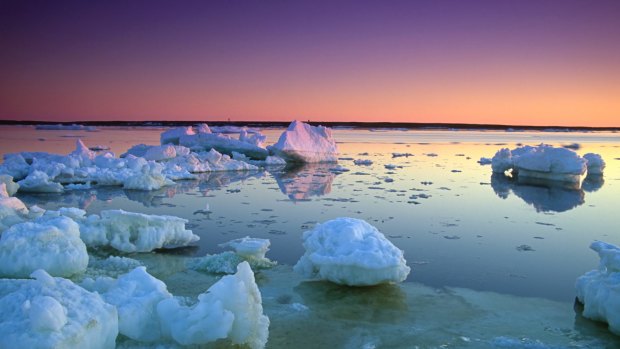
The polar regions offer spectacular photo opportunities, but make sure you take a backup device as conditions are challenging for electronics.Credit: graphicjackson
Both are otherworldly places of furious extremes, where unfamiliar rhythms and patterns will keep you in a perpetual state of wonder. Both offer glimpses of life lived on the edge, where there is little room for second chances. Both will strip you bare, turning you into a wiser and more humble version of yourself.
For all their similarities, the two regions are polar opposites. Put simply, Antarctica is a continent surrounded by sea, while the Arctic is sea surrounded by continents.
To ensure you have a better time than Cherry-Garrard here are some pointers to help you choose the best journey in the world (for you), plus insider tips from industry experts.
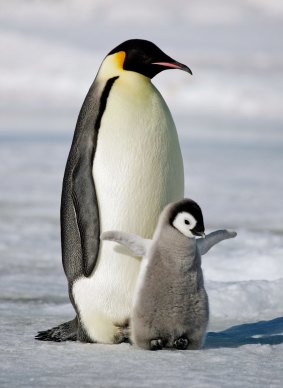
Nothing can prepare you for your first penguin sighting.
THE BIOLOGY
PENGUINS VERSUS POLAR BEARS
Let's get the obvious out of the way first – polar bears can only be found in the Arctic. If you want to see penguins, you'll need to head south.
Nothing can prepare you for your first sighting in Antarctica of gentoo penguins using ice floes as slippery dips, or adelies, the pirates of the penguin world, pinching pebbles for their nests.
Other rock stars include humpback whales sly-eyeing you from a Zodiac and orcas spraying geysers into the frozen air. And then there are the seals; from doe-eyed Weddells to brutal leopards, elephants to crabeaters, their antics bringing drama and comedy to all excursions.
If you have a penchant for polar bears, an expedition cruise to Arctic Svalbard is one of the best way to see bears on ice. Svalbard, together with the Russian-controlled archipelagos of Franz Josef Land and Novaya Zemlya, is home to about 3000 polar bears.
Daily outings will also serve up Svalbard reindeers, Arctic foxes, walruses, ringed seals, beluga whales and eider ducks. Even unicorns (narwhals) might grace you with their presence. In the polar regions, once-in-a-lifetime experiences happen daily.
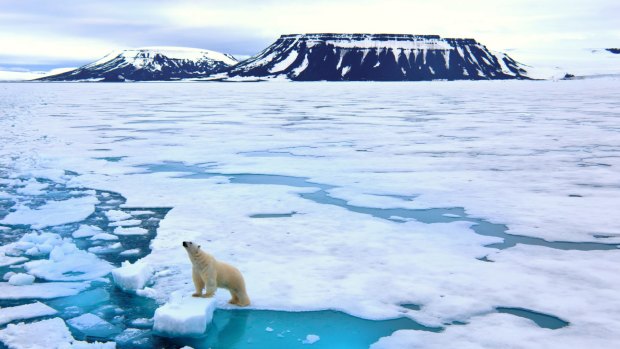
A cruise to Arctic Svalbard is one of the best way to see bears on ice.Credit: iStock
Insider tip
"Most people go to the Antarctic for the penguins, but often leave most inspired by the massive ice bergs. In the Arctic they go for the polar bears, but often leave remembering the dazzling change of colours and wide open spaces of the tundra." Sven Lindblad, CEO Lindblad Expeditions
THE ICE
This is what you travel to the ends of the earth for – ice. A welded wilderness of drama and light, where ice palaces stand as tall as skyscrapers and pack ice floats like fragments of broken china. Kayak through an ice slushy; hear the clap of a calving glacier; and watch as halos and arcs dance across a frozen sea.
Under a leaden sky you'll learn a whole new vocabulary – bergy bits, growlers, floaters and drifters – and see wonders you could only dream about. Such as Antarctica's Iceberg Alley, where an armada of blue bergs stretches to the horizon, or Svalbard's Austfonna ice cap, one of the largest in the world.
On a sobering note, the mean annual air temperature of both the Arctic and Antarctic is continuing to rise, with both poles experiencing record lows in sea ice extent in 2016.
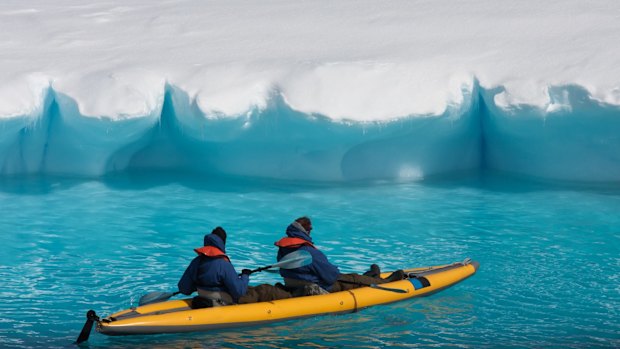
Kayak through an ice slushy among icebergs in Antarctica.Credit: iStock
Insider tip
"The Arctic is warming beyond natural trends, sea ice is declining, glaciers are retreating, and polar bear habitats are shrinking. From the comfort of your home this may be hard to visualise, but by coming here you can see it happening before your own eyes." Dr Andrew Clarke, Emeritus Fellow British Antarctic Survey
THE CROSSING
Rite of passage or water torture? The Drake Passage, that rowdy stretch of water between the tip of South America and the northernmost shores of Antarctica, is perhaps the most feared (or anticipated) crossing in the world. It takes about two days, but the time passes quickly, with bird watching, scientific lectures and the honing of that most important skill – not spilling your G&T.
Accessing the Arctic is generally a smoother ride, with charter flights capable of bringing passengers closer to the ice before boarding expedition ships. However, any body of water can be rough, given the right mix of conditions. Pressure bands, over-the-counter medications and not overeating (or drinking) for the first few days can help.
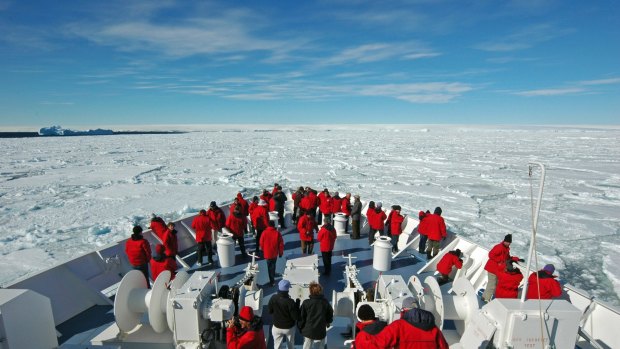
Expedition ship, Orion, pushes gingerly through the pack ice. Credit: iStock
Insider tip
"After 100-plus voyages to Antarctica I've spent more than a year of my life in the Drake Passage. While it can be rough that's not very often – about as often as it's dead calm. Mostly you just have some rolling and pitching. The good news is that it's calm seas once you reach Antarctica and I estimate less than half of those who are seasick heading south are seasick on the return voyage – most now have their sea legs." David McGonigal, Expedition Leader for One Ocean Expeditions
THE LANDINGS
Whether you visit the Arctic or Antarctic, shore landings by Zodiac are a highlight of every expedition. The big difference between north and south is the need for Arctic guides to carry rifles due to the threat of polar bears. In Antarctica, the only surprise attack might come from a playful penguin pecking at your ankles.
If you are concerned about any landings or shore-based hikes, most operators also offer passengers the option of a Zodiac tour without a landing, or a range of hikes catering for slow, medium and fast walkers. "More walk-less talk", or "more talk-less walk" are common options.
Insider tip
"In the Arctic you must remain close to your armed guide. Polar bears are very skilled hunters, and with the impacts of climate change are becoming bolder every year, so you definitely don't want to get too close!" Adam Cropp, Lindblad Expeditions National Geographic expedition leader and naturalist.
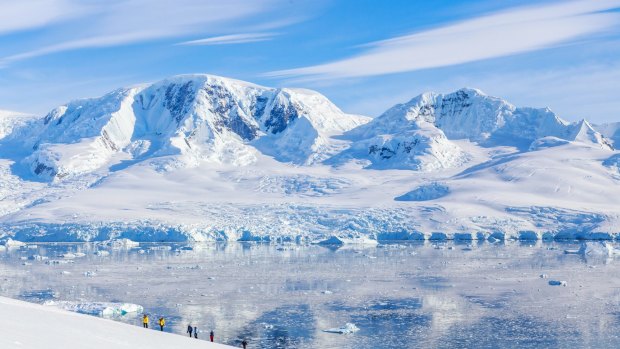
Group of people hiking the snowy mountains, Antarctic.Credit: iStock
THE WEATHER
On average, Antarctica is the colder cousin, due mainly to its height above sea level and because a massive ice sheet covers almost all of the continent, whereas the Arctic is kept relatively warm by its position in the middle of an ocean. Blizzards can erupt without warning, dropping temperatures to minus-20 degrees, even colder with wind chill. Consequently, safety precautions are enforced and reinforced at every briefing and landing.
Part of staying safe is dressing properly, and this means layering. Start with a full set of thermals, cover with fleeces and sweaters, and top off with an insulated, fully waterproof outer jacket (some companies, such as Lindblad Expeditions, supply these to guests). You'll also need waterproof pants, ski mittens or gloves, woollen beanie and neck warmer, long woollen socks, fully waterproof knee-high rubber boots and sunglasses. And don't forget swimmers for the "polar plunge".
On a practical note, the extreme weather can play havoc with photography equipment – batteries die, gear malfunctions, and kamikaze cameras can leap like lemmings from Zodiacs. As a minimum, you should carry spare batteries and a second camera (smartphones are an ideal backup). Serious photographers will bring a full arsenal of gear, often competing with each other for the biggest lens, but don't overlook a wide-angle lens for landscape shots and when you find yourself up close and personal with inquisitive penguins.
Insider tip
"Whether you head north or south you are going to be cold. Very cold. A waterproof camera bag, a cotton lens cloth and some warm gloves are essential gear for a journey to the polar regions." Rich Reid, National Geographic Photographer
THE PORTS
Antarctica has two primary access points: the Antarctic Peninsula, reached from Ushuaia (Argentina) or Punta Arenas (Chile) via the Drake Passage, or the Ross Sea/Commonwealth Bay region, accessed from New Zealand or Tasmania. From Ushuaia the crossing takes about two days, or the journey can be extended with detours to the Falkland Islands, South Georgia and South Shetland Islands. From New Zealand or Australia, it takes up to seven days to reach Antarctica, with potential pit stops at Macquarie Island, Auckland Islands and Campbell Island.
The Arctic has two main gateways: North America or Europe. Departures points include Resolute in the Canadian Arctic, Longyearbyen on Spitsbergen, Reykjavik in Iceland and Aberdeen in Scotland. If you have a liking for Vikings take an expedition from Greenland to Iceland, or for Inuit culture head to the Canadian High Arctic. Some cruises depart from Anadyr or Murmansk in Russia.
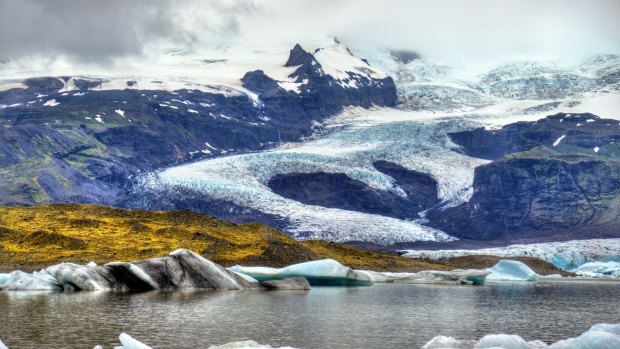
View of Fjallsarlon Glacier Lagoon in South Iceland.Credit: iStock
Insider tip
"Having spent the best part of two years of my life living in both the Arctic and Antarctic, life on the top and the bottom of the world is stripped down to its raw ingredients. The very magic of the Arctic and Antarctica – its ice – has become a modern-day tragedy. We watch as country-sized servings of millennia-old ice break off Antarctica and for the first time in human history, modern polar explorers will have to compete by kayak to reach the North Pole." Alexander Kumar, British Global Health medical doctor and photographer.
IT'S ALL IN THE NUMBERS
1. 20,000-25,000 – estimated number of polar bears left in the world. Antarctic penguins (including chinstrap, adelie, emperor, gentoo and macaroni) are a bit more prolific at 5 million.
2. 2835 metres – elevation above sea level at the geographic South Pole. In comparison, the geographic North Pole is in the Arctic Ocean, where the water is about 4000 metres deep and covered with constantly shifting sea ice up to two metres thick.
3. Two – number of species of flowering plants found in Antarctica (Antarctic hair grass and Antarctic pearlwort). In comparison, the Arctic is home to about 3000 species of flowering plants.
4. Zero – permanent population of Antarctica. Although about 30,000 tourists visited (landed) in 2015-16 and another 4000-5000 people stayed at scientific research stations. The Arctic – including parts of Alaska, Canada, Finland, Greenland, Iceland, Norway, Russia and Sweden – has a permanent population of about 4 million.
5. -89.2 degrees – Lowest temperature ever recorded on earth at the Soviet Vostok Station in Antarctica. In comparison the lowest temperature recorded in the Arctic was a balmy -67.8 degrees at Oymyakon and Verkhoyansk, both in Siberia.
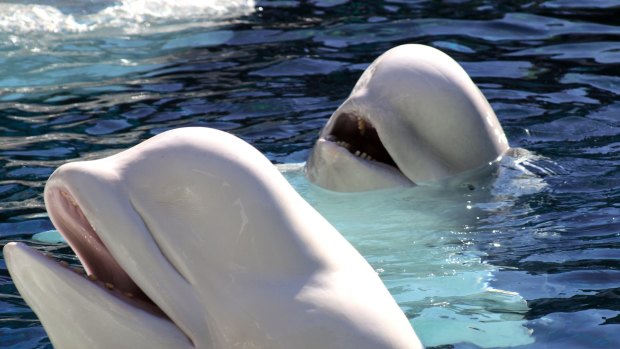
Two beluga whales, recognisable by their white colouring and blobby head. Credit: iStock
FIVE LEGENDARY ANIMALS TO WATCH OUT FOR
1. BELUGA WHALES
Nicknamed "sea canaries" (because of their chirps, clicks and whistles), this small whale is easily recognisable thanks to its stark white colouring and big blobby head. Found in the Arctic and subarctic waters.
2. NARWHALS
The "unicorn of the sea", this medium-sized whale possesses a swordlike "tusk" from a protruding canine tooth. While scientists are not certain of the tusk's purpose, it is likely to be used for some kind of mating ritual. Found on Arctic coastal waters and rivers.
3. ARCTIC TERNS
This tiny little bird makes the longest migration of any animal in the world, playing hopscotch between Greenland and Antarctica each year, clocking 71,000 frequent flier kilometres for its round trip. Found in the Arctic over April/May when they mate, nest and rear their young, before heading to Antarctica in November, where they stay until February/March.
4. WANDERING ALBATROSS
The bird "that made the breeze to blow" has the longest wingspan of any bird – up to 3.5 metres. Happy to fly 1000 kilometres for a snack, these majestic creatures spend most of their time in flight, soaring over the southern oceans. They breed on a number of subantarctic islands, including South Georgia and Prince Edward islands, and Crozet and Kerguelen islands.
5. KILLER WHALES (ORCAS)
A highly intelligent, social whale and one of the world's most powerful predators. Watching a pod of killer whales co-operatively hunting for prey is the holy grail of any polar passage. Although they are found in every ocean, they are most common in the icy waters of Antarctica, Iceland, Norway and Alaska.
TRIP NOTES
MORE
FLY
Thai Airways flies from Sydney and Melbourne to Oslo via Bangkok. See thaiairways.com. Longyearbyen is a three-hour flight from Oslo.
LATAM Airlines flies from Sydney to Buenos Aires, Argentina (via Santiago, Chile). Melbourne passengers connect in Sydney. See latam.com
CRUISE
Lindblad Expeditions offers a 10-day Land of the Ice Bears: An in-depth exploration of Arctic Svalbard from $12,780, including two nights in Oslo, meals, bar tab and tips, excursions and charter flights to/from Longyearbyen (international flights excluded). Expeditions depart May and June. See expeditions.com
Lindblad Expeditions offers a 22-day trip to Antarctica, South Georgia and the Falklands from $29,740, including overnight in Buenos Aires or Santiago, meals, bar tab and tips, excursions and charter flights to Ushuaia. Expeditions depart November to February. See expeditions.com
Kerry van der Jagt was a guest of Lindblad Expeditions and LATAM Airlines
Sign up for the Traveller Deals newsletter
Get exclusive travel deals delivered straight to your inbox. Sign up now.